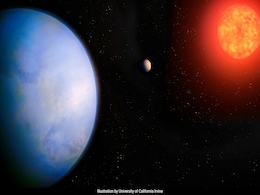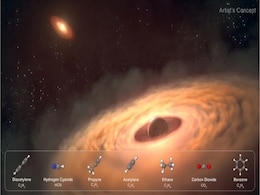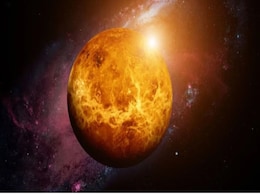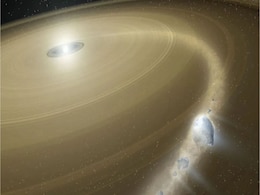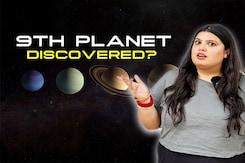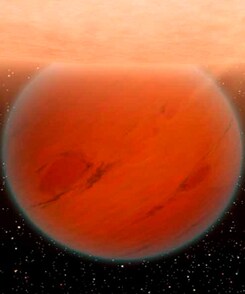Planet Discovery
- All
- News
- Videos
- Web Stories
-

Hubble Captures Rare Collision in Nearby Planetary System, Revealing Violent Planet Formation
- Friday December 19, 2025
Astronomers using NASA’s Hubble Space Telescope have witnessed rare collisions between rocky bodies in the Fomalhaut system. The glowing debris clouds created by these impacts offer a unique glimpse into how planets form and highlight challenges in identifying true exoplanets.
-
 www.gadgets360.com
www.gadgets360.com
-

JWST Detects Thick Atmosphere on Ultra-Hot Rocky Exoplanet TOI-561 b
- Sunday December 14, 2025
Astronomers using the James Webb Space Telescope have discovered compelling evidence of a thick atmosphere surrounding TOI-561 b, an ultra-hot rocky exoplanet orbiting its star every 11 hours. Despite extreme radiation and molten surface conditions, the planet appears cooler than expected, suggesting heat-redistributing atmospheric winds and volati...
-
 www.gadgets360.com
www.gadgets360.com
-

NASA's James Webb Space Telescope Telescope Challenges Old Theories on Mini-Neptune Worlds
- Friday November 7, 2025
New models suggest mini-Neptunes—planets smaller than Neptune with thick gas envelopes—may have solid rocky surfaces instead of molten magma. Data from NASA’s JWST revealed high-pressure atmospheres capable of compressing molten rock into solid crusts. This discovery challenges earlier assumptions and offers key insights into exoplanet compos...
-
 www.gadgets360.com
www.gadgets360.com
-

Newly Found ‘Super-Earth’ GJ 251 c Could Be One of the Most Promising Worlds for Alien Life
- Sunday October 26, 2025
A new super-Earth, GJ 251 c, has been found orbiting a nearby red dwarf star within its habitable zone. About four times Earth’s mass, it may host liquid water. Detected via the radial-velocity method using Penn State’s Habitable Zone Planet Finder, it’s a prime target in the search for life.
-
 www.gadgets360.com
www.gadgets360.com
-

Kepler and TESS Discoveries Help Astronomers Confirm Over 6,000 Exoplanets Orbiting Other Stars
- Saturday December 13, 2025
More than 6,000 exoplanets (planets orbiting other stars), one of the most rapidly expanding frontiers in science, have now been confirmed by astronomers. Their search of other worlds has been transformed within a span of thirty years, which started as a form of speculation, to accurate detection. However, in the midst of this wave of discoveries, ...
-
 www.gadgets360.com
www.gadgets360.com
-

Astronomers Capture First-Ever Image Of A Baby Planet Forming In Real Time
- Tuesday October 7, 2025
- Science |
Astronomers have made a groundbreaking discovery by directly observing a young protoplanet, WISPIT 2b, embedded in a ring-shaped gap in a disk around a young star.
-
 www.ndtv.com
www.ndtv.com
-

Astronomers Spot Rapidly Growing Rogue Planet Feeding on Surrounding Gas
- Sunday October 5, 2025
Astronomers have discovered that Cha 1107-7626, a rogue planet 620 light-years away, is now the fastest-growing planet ever observed. The massive world consumes six billion tonnes of gas per second, a rate never before recorded. The findings suggest rogue planets can grow in star-like ways, reshaping how scientists view free-floating planetary obje...
-
 www.gadgets360.com
www.gadgets360.com
-

James Webb Offers First Glimpse Into How Moons Are Built Around Distant Planets
- Wednesday October 1, 2025
The James Webb Space Telescope has detected carbon-bearing molecules in a moon-forming disk surrounding CT Cha b, a massive planet-like object orbiting a young star 625 light-years away. The discovery marks the first measurement of its kind and offers clues to how moons like those around Jupiter and Saturn might have formed.
-
 www.gadgets360.com
www.gadgets360.com
-

Scientists May Finally Explain Mysterious Crown-Like Features on Venus
- Tuesday September 30, 2025
Venus’ distinctive crown-like coronae may be explained by heat trapped beneath a rigid mantle layer, according to recent studies. This discovery provides key insights into the planet’s geological activity and helps researchers compare Venus’ surface evolution to that of other planets in our solar system
-
 www.gadgets360.com
www.gadgets360.com
-

Hubble Spots White Dwarf Devouring Icy Pluto-Like Planet 260 Light-Years Away
- Wednesday September 24, 2025
Using Hubble’s ultraviolet spectrograph, scientists detected carbon, nitrogen, sulphur, and abundant oxygen falling onto a white dwarf 260 light-years away, evidence of an icy planetesimal being torn apart. The find shows volatile worlds can persist into a star’s final stages, offering a preview of the Sun’s distant fate.
-
 www.gadgets360.com
www.gadgets360.com
-

Exoplanets Explained: How Astronomers Find Worlds Orbiting Stars Beyond the Sun
- Monday September 8, 2025
Exoplanets are planets orbiting stars outside our solar system, hidden by stellar glare and detected indirectly. Astronomers identify them by tracking star wobbles or dips in brightness during planetary transits. NASA’s Kepler mission revealed thousands, with TESS now expanding the search. These discoveries confirm that planetary systems are abun...
-
 www.gadgets360.com
www.gadgets360.com
-

Hubble Captures Rare Collision in Nearby Planetary System, Revealing Violent Planet Formation
- Friday December 19, 2025
Astronomers using NASA’s Hubble Space Telescope have witnessed rare collisions between rocky bodies in the Fomalhaut system. The glowing debris clouds created by these impacts offer a unique glimpse into how planets form and highlight challenges in identifying true exoplanets.
-
 www.gadgets360.com
www.gadgets360.com
-

JWST Detects Thick Atmosphere on Ultra-Hot Rocky Exoplanet TOI-561 b
- Sunday December 14, 2025
Astronomers using the James Webb Space Telescope have discovered compelling evidence of a thick atmosphere surrounding TOI-561 b, an ultra-hot rocky exoplanet orbiting its star every 11 hours. Despite extreme radiation and molten surface conditions, the planet appears cooler than expected, suggesting heat-redistributing atmospheric winds and volati...
-
 www.gadgets360.com
www.gadgets360.com
-

NASA's James Webb Space Telescope Telescope Challenges Old Theories on Mini-Neptune Worlds
- Friday November 7, 2025
New models suggest mini-Neptunes—planets smaller than Neptune with thick gas envelopes—may have solid rocky surfaces instead of molten magma. Data from NASA’s JWST revealed high-pressure atmospheres capable of compressing molten rock into solid crusts. This discovery challenges earlier assumptions and offers key insights into exoplanet compos...
-
 www.gadgets360.com
www.gadgets360.com
-

Newly Found ‘Super-Earth’ GJ 251 c Could Be One of the Most Promising Worlds for Alien Life
- Sunday October 26, 2025
A new super-Earth, GJ 251 c, has been found orbiting a nearby red dwarf star within its habitable zone. About four times Earth’s mass, it may host liquid water. Detected via the radial-velocity method using Penn State’s Habitable Zone Planet Finder, it’s a prime target in the search for life.
-
 www.gadgets360.com
www.gadgets360.com
-

Kepler and TESS Discoveries Help Astronomers Confirm Over 6,000 Exoplanets Orbiting Other Stars
- Saturday December 13, 2025
More than 6,000 exoplanets (planets orbiting other stars), one of the most rapidly expanding frontiers in science, have now been confirmed by astronomers. Their search of other worlds has been transformed within a span of thirty years, which started as a form of speculation, to accurate detection. However, in the midst of this wave of discoveries, ...
-
 www.gadgets360.com
www.gadgets360.com
-

Astronomers Capture First-Ever Image Of A Baby Planet Forming In Real Time
- Tuesday October 7, 2025
- Science |
Astronomers have made a groundbreaking discovery by directly observing a young protoplanet, WISPIT 2b, embedded in a ring-shaped gap in a disk around a young star.
-
 www.ndtv.com
www.ndtv.com
-

Astronomers Spot Rapidly Growing Rogue Planet Feeding on Surrounding Gas
- Sunday October 5, 2025
Astronomers have discovered that Cha 1107-7626, a rogue planet 620 light-years away, is now the fastest-growing planet ever observed. The massive world consumes six billion tonnes of gas per second, a rate never before recorded. The findings suggest rogue planets can grow in star-like ways, reshaping how scientists view free-floating planetary obje...
-
 www.gadgets360.com
www.gadgets360.com
-

James Webb Offers First Glimpse Into How Moons Are Built Around Distant Planets
- Wednesday October 1, 2025
The James Webb Space Telescope has detected carbon-bearing molecules in a moon-forming disk surrounding CT Cha b, a massive planet-like object orbiting a young star 625 light-years away. The discovery marks the first measurement of its kind and offers clues to how moons like those around Jupiter and Saturn might have formed.
-
 www.gadgets360.com
www.gadgets360.com
-

Scientists May Finally Explain Mysterious Crown-Like Features on Venus
- Tuesday September 30, 2025
Venus’ distinctive crown-like coronae may be explained by heat trapped beneath a rigid mantle layer, according to recent studies. This discovery provides key insights into the planet’s geological activity and helps researchers compare Venus’ surface evolution to that of other planets in our solar system
-
 www.gadgets360.com
www.gadgets360.com
-

Hubble Spots White Dwarf Devouring Icy Pluto-Like Planet 260 Light-Years Away
- Wednesday September 24, 2025
Using Hubble’s ultraviolet spectrograph, scientists detected carbon, nitrogen, sulphur, and abundant oxygen falling onto a white dwarf 260 light-years away, evidence of an icy planetesimal being torn apart. The find shows volatile worlds can persist into a star’s final stages, offering a preview of the Sun’s distant fate.
-
 www.gadgets360.com
www.gadgets360.com
-

Exoplanets Explained: How Astronomers Find Worlds Orbiting Stars Beyond the Sun
- Monday September 8, 2025
Exoplanets are planets orbiting stars outside our solar system, hidden by stellar glare and detected indirectly. Astronomers identify them by tracking star wobbles or dips in brightness during planetary transits. NASA’s Kepler mission revealed thousands, with TESS now expanding the search. These discoveries confirm that planetary systems are abun...
-
 www.gadgets360.com
www.gadgets360.com







